The Icefields Parkway out of Jasper National Park in Alberta, Canada, took us through the Canadian Rockies in our search for glacial waterfalls. The Athabasca Falls. The Sunwapta Falls. Stunning. Thundering. Scouring. Roiling. Crashing. A milky turquoise from the diffusion of glacial silt.
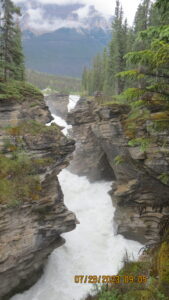
When glaciers form, they scrape layers of land from mountainsides. As glaciers melt and recede, they leave behind moraine; a mound of boulders, gravel, sand, and debris, in their retreat up the mountainside. The silt is fine rock or sand grounded by glaciers and carried by meltwaters from friction of movement as glaciers grow or recede.
The trails to these waterfalls weren’t difficult to hike. Just covered in exposed roots from all the foot traffic around the forest floor by the falls. I remember telling my husband I believed the trees resented all these people stepping on their “toes.”
He agreed and said that’s why the trees raise their roots every now and then to trip someone.
I guess fair is fair.
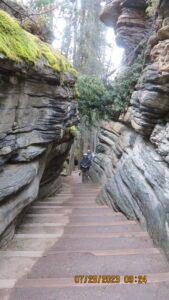
The Athabasca Falls trail had a “Tunnel of Time,” I called it. An ancient water channel from the Athabasca River. The rock layers sat parallel to us as we journeyed inside this channel. Each slab of rock held a story, a slice of history. Ragged. Shaped and sanded by raging water and silt through time.
I discovered stone steps down to the river, so I went to test the water. The Athabasca is bone chilling and beautiful. Nothing could survive this frigidity for long, I thought.
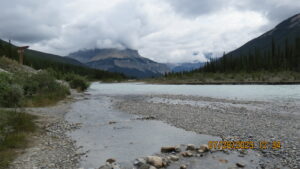
The Athabasca is fed from the mountains and the glaciers. The river winds its way along the valley floor, leaving milky alluvial strands along the riverbed throughout the town of Jasper. According to our tramcar guide from Whistler’s Mountain, the Athabasca is the longest river in the area. It begins at the Columbia Icefields and flows north, to mix with other rivers, finally ending up in the Bering Strait.
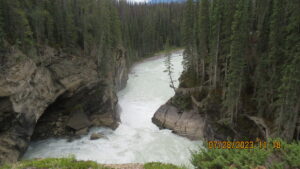
We drove along the Icefields Parkway toward Sunwapta Falls as I tried to discern why these waterfalls fascinated me so. I love all waterfalls. But we don’t have the beauty of glaciers to color our waterfalls in the lower United States. This is what makes these falls worth the trip to see. The geology of the surrounding mountains and the creation of the waterfall. The power of water and silt from glaciers to challenge the landscape. Scour mountainsides. Carve caves and valleys. And augment the color of water.
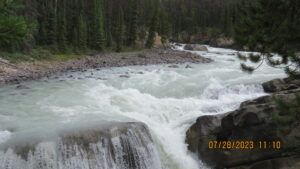
The Sunwapta Falls trail climbed and dipped through a forest of pine, quaking aspen, and birch. The Sunwapta is also a glacier-fed river, milky white turquoise in color. Rapids race downstream, whitecaps dancing on the surface. The upper fall thundered over a rock ledge that spanned the river. It was as if the riverbed dropped about three feet in height, a mere giant’s step in the water. The second fall tumbled over boulders barely submerged in the raging river.
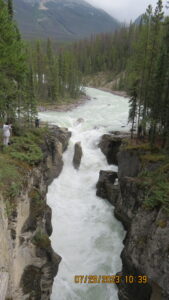
I continued my trek downriver. The last waterfall crashed down the gorge. Rocky ledges pinched in the river at one point. As if the mountainsides refused to let the mighty river devour those last ridges. The Sunwapta retaliated, roiling and kicking and thundering downstream.
The Sunwapta trail was the longer hike, about two miles, but these glacial falls made the journey worth it.
How about you? Do you like waterfalls? Have you seen any interesting falls? Please share in the comments. Thanks! Enjoy your adventures.


Waterfalls are never the same. Gentle and fierce ,soothing and exciting, and always beautiful.
So true, William. Thank you for reading my post and leaving a note. Have a beautiful day!